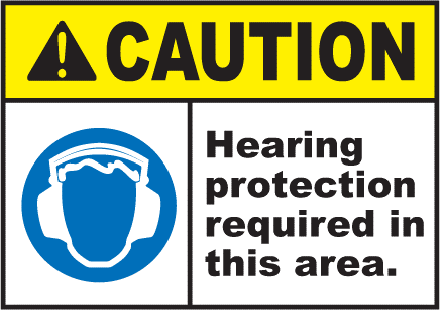The University of Kentucky is committed to providing work, study, and research environments that are free from recognized hazards, including those that result from high-noise environments. The purpose of the Hearing Conservation Program is to provide for the protection of University personnel from long term hearing loss associated with noise levels in the workplace in compliance with the Occupational Safety and Health Administration (OSHA) 29 CFR Part 1910.95, Occupational Noise Exposure in General Industry, and 29 CFR 1926.52, Occupational Noise Exposure in Construction.
Hearing Conservation & Noise
Hearing Conservation & Noise
General Information About Noise
Many factors influence an individual's actual noise exposure. For an accurate reading for any one individual, he/she would need to wear a noise dosimeter during the actual exposure. (A noise dosimeter is basically a noise meter worn for a certain period of time.) For any particular noise source, those individuals who are able to separate themselves with physical barriers from the noise would be exposed at a lower volume than an individual standing next to the noise source. On top of physical separations, such as walls, the distance from a sound source greatly influences the exposure.
As far as OSHA regulations are concerned, the energy produced by a noise source doubles at every 5 dB. Therefore, 90 dB is not twice the energy of 45 dB but is twice the energy of 85dB. Many other entities actually consider a 3 dB increase as the doubling of energy and, technically speaking, this is the most accurate. And it's the energy produced by a noise source that makes its way into the inner ear of an individual. With enough energy, noise can produce injury to the inner ear.
Using OSHA criteria, an average exposure of 85 dBA (dBA being a weighted scale matching the hearing threshold of the human ear) over 8 hours is enough energy to put an employee into a hearing conservation program, requiring hearing protection to be worn. However, if the noise source is generating 90 dBA, that’s twice the energy and, therefore, only four (4) hours of exposure leads to the employee being placed in a hearing conservation program. Going further, 95 dBA for only two (2) hours and 100 dBA for only one (1) hour are equivalent to the others here.
Hearing Conservation Program (HCP)
All UK personnel whose noise exposures equal or exceed an 8-hour time weighted average (TWA) of 85 decibels, also known as the OSHA action level, must be enrolled in a HCP. The hearing conservation program includes:
- Annual monitoring of noise exposures
- Annual training on noise exposures
- Use of hearing protectors
- Annual audiometric testing
Recognition and Evaluation of Noise Sources
When information indicates that any employee's exposure may equal or exceed 85 decibels (8-hour TWA), the department is to notify UK Occupational Health & Safety (OHS) to implement a monitoring program. The noise survey is performed using a sound level meter (A-scale, slow response) and/or noise dosimeter for evaluation of personal exposures. Monitoring shall be repeated whenever a change in production, process, equipment or controls increases noise exposures to the extent that additional employees may be exposed at or above the action level; or the attenuation provided by hearing protectors being used by employees is not adequate.
Audiometric Testing
Annual audiometric testing is performed by a licensed or certified audiologist. A baseline audiogram is obtained within 6 months of an employee's first exposure at or above the action level. The baseline audiogram is established to compare against subsequent audiograms. Employees are to be notified, in writing, of the results of exams. When there is a verified standard threshold shift, the employee must be notified within 21 days after verification.
Control of Noise Source
When employees are subjected to sound levels exceeding 85 decibels (8-hour TWA), feasible administrative or engineering controls are to be utilized. Types of administrative controls are rotation of employees, limiting time of certain operations, or restricting areas or work operations. Engineering controls include maintenance, modifying equipment, substitution of equipment, isolation, and acoustic material.
Hearing Protection Devices
If feasible engineering or administrative controls cannot be accomplished, personal hearing protective devices must be provided and used to reduce sound levels in areas above 85 dBA. The hearing protection used will depend on the operation, employee preference and attenuation required. UK OHS can assist in supplying information on attenuation data and supervise the correct use of hearing protectors. Employees are given the opportunity to select their hearing protectors from a variety of suitable types. Personal protective devices should also be used during non-routine, infrequent operations, which do not warrant special engineering control.
For employees who have experienced a standard threshold shift, hearing protectors must attenuate employee exposure to an 8-hour time-weighted average of 85 decibels or below. The adequacy of hearing protector attenuation shall be re-evaluated whenever employee noise exposures increase to the extent that the hearing protectors provided may no longer provide adequate attenuation.
Signs
Signs are to be posted in areas where noise levels are above 85 dBA stating that hearing protection is required.
Training
An annual training program is provided for each employee included in the hearing conservation program. The training program includes effects of noise on hearing; the purpose of hearing protectors, and instruction on their selection, fitting, use, and care; and the purpose of audiometric testing.
Noise Information
- CDC: How to Wear Soft Foam Earplugs
- CDC Power Tools Database
- Sound specifications for various types of power tools.
- NASA Education Auditory Research (EAR) Lab
- OSHA Occupational Noise Exposure Standard
